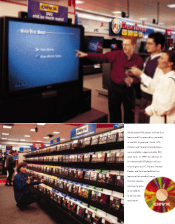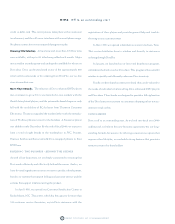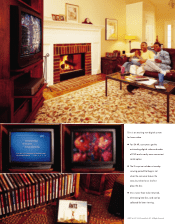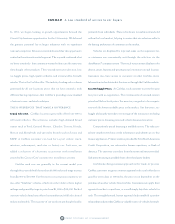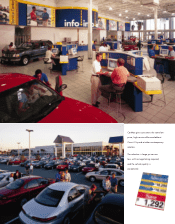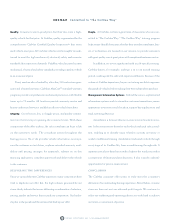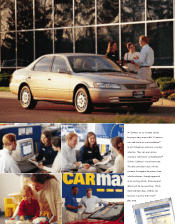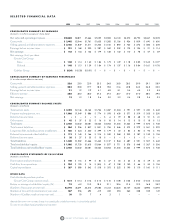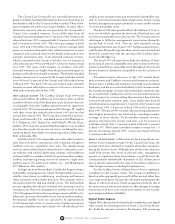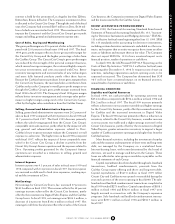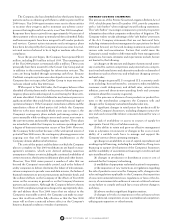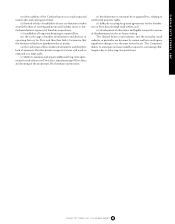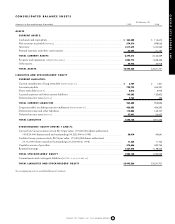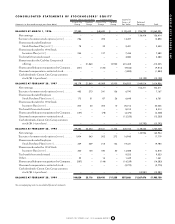CarMax 1999 Annual Report Download - page 27
Download and view the complete annual report
Please find page 27 of the 1999 CarMax annual report below. You can navigate through the pages in the report by either clicking on the pages listed below, or by using the keyword search tool below to find specific information within the annual report.
interest is held by the prominent Los Angeles law firm Ziffren,
Brittenham, Branca &Fischer. The Company’s investment in Divx
is allocated to the Circuit City Group. Through the end of the fiscal
year, the Company had invested $207 million in Divx, $120 mil-
lion of which was invested in fiscal 1999. The investment in Divx
impacts the Company’s and the Circuit City Group’s gross profit
margin and selling, general and administrative expense ratio.
Cost of Sales, Buying and Warehousing
The gross profit margin was 22.6 percent of sales in fiscal 1999 com-
pared with 23.0 percent in fiscal years 1998 and 1997. The fiscal
1999 gross profit margin reflects a lower gross profit margin for
the Circuit City Group and the higher percentage of sales from
the CarMax Group. The Circuit City Group’s gross profit margin
was reduced by the strength of the personal computer business,
which carries lower gross margins; the continued highly competi-
tive price environment; and costs associated with Divx. Better
inventory management and increased sales of new technologies
and more fully featured products partly offset these factors.
Because the CarMax business produces lower gross margins than
the Circuit City business, the increased sales contribution from
CarMax reduces the Company’s overall gross profit margin even
though the CarMax Group’s gross profit margin increased from
fiscal 1998 to fiscal 1999. The Company’s fiscal 1998 gross margin
reflects better inventory management and a stronger sales perfor-
mance in higher margin categories for the Circuit City Group,
offset by the higher sales contribution from the CarMax Group.
Selling, General and Administrative Expenses
Selling, general and administrative expenses were 20.2 percent of
sales in fiscal 1999 compared with 20.8 percent in fiscal 1998 and
19.7 percent in fiscal 1997. The fiscal 1999 decrease primarily
reflects the sales leverage gained from the Circuit City Group’s
comparable store sales increase, partly offset by the impact of sell-
ing, general and administrative expenses related to Divx.
CarMax’s lower expense structure reduces the Company’s overall
expense-to-sales ratio. The higher ratio in fiscal 1998 compared
with fiscal 1997, reflects the impact of lower comparable store
sales for the Circuit City Group, a decline in profits from the
Circuit City Group’s finance operation and the expenses related to
Divx. Operating profits generated by the Company’s finance
operations are recorded as a reduction to selling, general and
administrative expenses.
Interest Expense
Interest expense was 0.3 percent of sales in fiscal years 1999 and
1998 compared with 0.4 percent in fiscal 1997. Interest expense
was incurred on debt used to fund store expansion, working capi-
tal and the investment in Divx.
Net Earnings
Net earnings for Circuit City Stores, Inc. increased 37 percent to
$142.9 million in fiscal 1999. The increase reflects the 48 percent
earnings increase achieved by the Circuit City business, partly
offset by the investment in Digital Video Express and the CarMax
Group losses. In fiscal 1998, net earnings were $104.3 million, a
decrease of 24 percent from $136.4 million in fiscal 1997. Net
earnings for all three fiscal years reflect the results of the Circuit
City business, the Company’s investment in Digital Video Express
and the losses incurred by the CarMax Group.
RECENT ACCOUNTING PRONOUNCEMENTS
In June 1998, the Financial Accounting Standards Board issued
Statement of Financial Accounting Standards No. 133, “Account-
ing for Derivative Instruments and Hedging Activities.” SFAS No.
133 is effective for fiscal years beginning after June 15, 1999. SFAS
No. 133 standardizes the accounting for derivative instruments,
including certain derivative instruments embedded in other con-
tracts, and requires that an entity recognize those items as either
assets or liabilities and measure them at fair value. The Company
does not expect SFAS No. 133 to have a material impact on its
financial position, results of operations or cash flows.
In April 1998, the AICPA issued SOP 98-5 “Reporting on the
Costs of Start-Up Activities.” SOP 98-5 is effective for fiscal years
beginning after December 15, 1998. It requires costs of start-up
activities, including organization and pre-opening costs, to be
expensed as incurred. The Company has determined that SOP
98-5 will not have a material impact on its financial position,
annual results of operations or cash flows.
FINANCIAL CONDITION
Liquidity and Capital Resources
In fiscal 1999, net cash provided by operating activities was
$254.2 million compared with $194.6 million in fiscal 1998 and
$14.2 million in fiscal 1997. The fiscal 1999 increase primarily
reflects a decrease in net accounts receivable and higher earnings
for the Circuit City business, partly offset by increased inventory
for CarMax and the increased investment in Digital Video
Express. The fiscal 1998 increase primarily reflects a reduction in
inventory related to the Circuit City business, a smaller increase
in net accounts receivable and a slight earnings increase for the
Circuit City business, partly offset by the investment in Digital
Video Express, greater automotive inventory to support a larger
number of CarMax superstore openings and a higher loss from the
CarMax business.
Most financial activities, including the investment of surplus
cash and the issuance and repayment of short-term and long-term
debt, are managed by the Company on a centralized basis.
Interest-bearing loans, with terms determined by the board of
directors, are used to manage cash between the Groups. These
loans are reflected as inter-group receivables or payables on the
financial statements of each Group.
Capital expenditures have been funded through sale-leaseback
transactions, landlord reimbursements, proceeds from the
CarMax Group equity offering and short- and long-term debt.
Capital expenditures of $367.0 million in fiscal 1999 reflect
Circuit City and CarMax stores opened or remodeled during the
year and a portion of the stores opening in fiscal 2000. The sale-
leaseback and landlord reimbursement transactions completed in
fiscal 1999 totaled $273.6 million. Capital expenditures of $588.1
million in fiscal 1998 and $542.0 million in fiscal 1997 were
largely incurred in connection with the Company’s expansion
programs. Sale-leaseback and landlord reimbursement transac-
tions were $297.1 million in fiscal 1998 and $332.7 million in
fiscal 1997.
CIRCUIT CITY STORES, INC.
CIRCUIT CITY STORES, INC. 1999 ANNUAL REPORT 25


